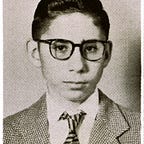Silvia Gallerano — She of the Liquid Eyes
Often I have written in these pages (monitor screens?) that when I see a beautiful landscape I never click or press any buttons. If possible I either buy a postcard or imprint the memory of the scene in my head. I eschew lit caves, fireworks, and, especially, sunsets. On a ship from Buenos Aires to Veracruz in my youth I photographed every sunset. Once was enough.
Street photography is of no interest to me now. I did that when I was in my 20s.
I am a photographer and I photograph the face, the human face. It is astounding for me to think (and I think this often) how a couple of eyes, ears, one nose and one mouth and hair can all add up to a mystery that is always unique and much more so than a fingerprint. How can that be?
In my life as a photographer I have photographed many faces. In the lingo of 21stcentury photography the expression “capture” almost conveys to me the taking away of something that is there for me to see and then to store it. In old fashioned film, that image or capture is latent. It has to be “developed out”. In modern digital cameras (or in my small supply of Fuji Instant Film) the captured face is there to be seen instantly. Unless of course, like death later, corruption can take over a digital storage card on the spot.
My little oficina has rows and rows of metal filing cabinets filled with negatives, transparencies and photographs of faces. I have captured them, haven’t I in some way? Perhaps a slice of wafer thinness (my camera does not shoot in three dimensions) that I have removed from my trusting subject.
But there is another way of looking at this and what I have in my filing cabinets. They are images of people who have allowed me to see in them what they want me to see. This may just coincide with what I think is in them. There is no way of knowing. In some rare cases both the photographer (me) and my subject may agree.
My hero, Argentine poet and writer Jorge Luís Borgen often wrote about his obsession with mirrors and of looking at himself in them. Once he became blind it was just a memory. Borges wrote:
A veces en las tardes una cara
nos mira desde el fondo de un espejo;
el arte debe ser como ese espejo
que nos revela nuestra propia cara.
My translation:
Sometimes in the afternoon a face
looks upon us from the depths of a mirror;
art must be like that mirror
that reveals our own face.
Such a face is the face of Italian actress (I am old-fashioned) Silvia Gallerano who is in town for performances of Cristian Cersoli’s La Merda at the Vancouver East Cultural Centre, here in Vancouver BC, until May 13..
It is a face with liquid eyes that for me mimicked a Borges mirror. As she faced my cameras today in my little studio, watched over by Cristian Cersoli, her daughter Lara and tour manager Marco Pavanelli, I felt as naked as she is during her performances. Her only protection might be the microphone she holds tightly close to her face. She smiles with her eyes and I had to instruct her not to. I was not going to tell her that in La Merda that naughty protagonist, a naughty male dolphin, has a built-in smile like all dolphins do.
I may have taken no more that fifteen exposures when I stopped. We had coffee and sweets and the lingua franca was a combination of Italian, Spanish and English.
Of the show, La Merda, that I saw with my wife Rosemary last week I can state that it was a performance that is in strange opposition to having met the star and talked to the quiet writer Ceresoli. Ultimately this has to do with the fact that nobody who is not an actor (and I am not one) can ever understand how someone can spill their life out with a microphone and then days later, no matter how many times it sinks in, the face in front of my camera with a microphone, and the face of the woman with a microphone at the Cultch are not the same.
I was captured by a face, by Silvia Gallerano and her liquid eyes.
Originally published at blog.alexwaterhousehayward.com.
